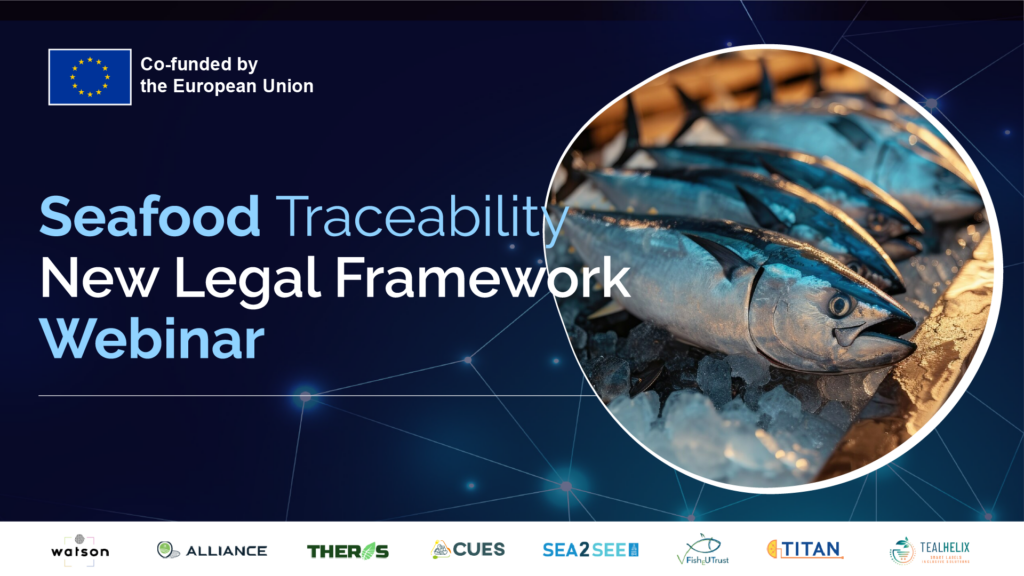
On April 3, SEA2SEE brought together over 80 stakeholders from across the European seafood value chain for an online webinar that couldn’t have come at a more timely moment. With the EU’s revised Fisheries Control Regulation entering into force, the session set out to explore not only what the new rules will mean in practice, but also how we can help to ensure that no actor is left behind in this transition.
For SEA2SEE, which aims to promote trust, transparency and sustainability in the seafood supply chain, this exchange reflected a fundamental aspect of the project’s mission: aligning regulatory frameworks with real-world needs through collaboration and knowledge sharing.
The regulation at a glance
At the centre of the discussion was the new Fisheries Control Regulation (EU 2023/2842), a major piece of legislation that introduces mandatory digital traceability for nearly all seafood products marketed in the EU. Starting in 2026 for fresh and frozen goods, and in 2029 for processed and algae-based products, operators will need to ensure that traceability data can be exchanged digitally at every step of the supply chain.
Opening the event, Anne Gautrais Le Goff, Policy Officer from DG MARE, provided an overview of the regulation’s scope and its intended impact. Beyond improved controls, she emphasized the new rules are about restoring trust—both with consumers, and between trading partners. With imports accounting for more than 70% of seafood consumed in the EU, aligning traceability standards across borders is not only a question of compliance but one of market fairness. EU producers, particularly those operating under rigorous sustainability commitments, deserve to compete on equal terms. And consumers, for their part, have a right to clear and reliable information about the products they buy.
Challenges from the ground up
However, it quickly became clear that the road to implementation is far from straightforward. José Bento, representing the small-scale fisheries sector and Low Impact Fishers of Europe (LIFE), offered a candid and critical perspective from the ground. While supportive of the principle of traceability, he highlighted the operational and financial challenges that many small vessels—some without even basic onboard power—will face in meeting digital requirements. Without proper support mechanisms and tools designed with end users in mind, there is a real risk that small-scale fishers, who already operate under tight margins, could be marginalised by the new system.
This concern was echoed by several participants, raising one of the central tensions at the heart of the new regulation: how to balance the ambition of a harmonised, digital-first system with the diverse realities of Europe’s seafood landscape. Not all actors are equally equipped to make the shift, and without inclusive solutions, the regulation could inadvertently create new disparities.
Making traceability feasible and fair
That’s where SEA2SEE’s role—and that of the wider EU Cluster for Food Traceability and Trust—becomes particularly important. As part of the cluster, SEA2SEE is not just monitoring the regulatory environment but is actively contributing to solutions that make compliance feasible and beneficial, especially for smaller operators. Through user-centric design, stakeholder dialogue and digital tool development, SEA2SEE is working to ensure that traceability isn’t just a legal requirement but a lever for value creation.
The webinar also highlighted the importance of consumer engagement. While the regulation mandates digital traceability across the supply chain, it does not yet require that this information be made accessible to consumers in a clear and comparable way. As several speakers noted, transparency only achieves its purpose when it is visible. Countries like Germany are already seeing strong market uptake of voluntary labelling schemes that communicate origin, sustainability, and even carbon footprint. These examples point to a broader opportunity: traceability can be a commercial asset, not just a compliance burden—if consumers are informed and able to act on it.
Looking ahead
The SEA2SEE team closed the session by underlining that the new legal framework represents both a challenge and a window of opportunity. For the regulation to fulfil its promise, implementation must be collaborative, inclusive and responsive to the needs of the entire seafood ecosystem. This means listening to small-scale fishers as much as tech developers, ensuring that traceability systems are not only robust but user-friendly.
The webinar was more than just an information session—it was a space for open exchange, critical reflection and collaborative problem-solving. SEA2SEE will continue these efforts, developing tools that bridge policy and practice, while raising consumer awareness across Europe.
Watch a recording of the webinar here
Contributor: Vitagora

